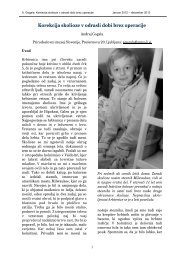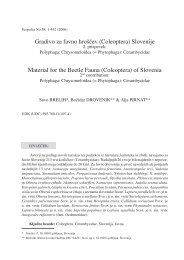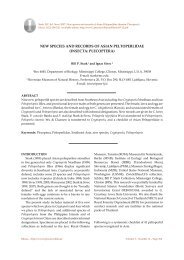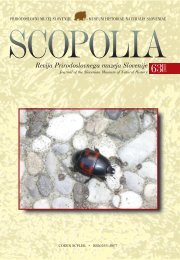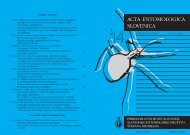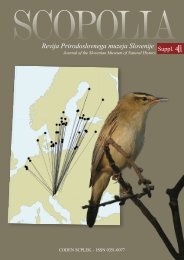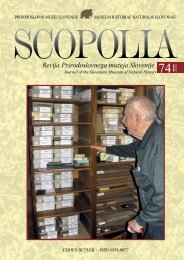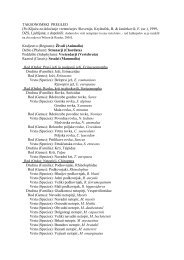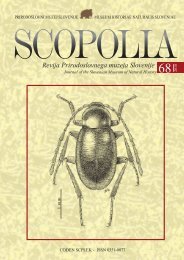ACTA BIANCO 2/2007.XP
ACTA BIANCO 2/2007.XP
ACTA BIANCO 2/2007.XP
Create successful ePaper yourself
Turn your PDF publications into a flip-book with our unique Google optimized e-Paper software.
<strong>ACTA</strong> ENTOMOLOGICA SLOVENICALJUBLJANA, JUNIJ 2010 Vol. 18, øt. 1: 31–46CONTRIBUTION TO THE KNOWLEDGEOF THE BUTTERFLY FAUNA OF THE REPUBLIC OF MACEDONIA(LEPIDOPTERA: PAPILIONOIDEA & HESPERIOIDEA)R. VEROVNIK 1 , B. MICEVSKI 2 , M. flURIÅ 3 , P. JAKØIÅ 4 , A. KEYMEULEN 5 ,C. VAN SWAAY 6 , K. VELING 61University of Ljubljana, Biotechnical Faculty, Department of Biology,Veœna pot 111, 1000 Ljubljana, Slovenia.rudi.verovnik@bf.uni-lj.si2Faculty of Natural Sciences, Institute of Biology, BSPSM,Gazi Baba b.b., Skopje, Macedonia.3Bulevar oslobofienja 106/34, 11000 Belgrade, Serbia.4Faculty of Science, University of Niø, 18000 Niø, Viøegradska 33, Serbia.5Rue Audrey Hepburn 6/C6, B-1090 Brussels, Belgium.6De Vlinderstichting (Dutch Butterfly Conservation), Postbus 506,NL-6700 AM Wageningen, The Netherlands.Abstract - A faunistic account of 121 observed species of butterflies is given forthe territory of Republic of Macedonia during the first week of June. Despite shortperiod of the time large part of Macedonia was surveyed and several interestingobservations were made. Among these new sites for some rare species like Melitaeaarduinna, Spialia phlomidis, Gegenes nostrodamus, Colias caucasica, Satyriumpruni, Satyrium w-album, Tarucus balkanicus, Cupido alcetas, and Araschnia levanashould be mentioned. Melitaea telona is reported for the first time forMacedonia. The lack of faunistic surveys and priorities in butterfly conservation inMacedonia are stressed.KEY WORDS: faunistics, distribution, threatened species, conservation, RhopaloceraIzvleœek – PRISPEVEK K POZNAVANJU FAVNE DNEVNIH METULJEVMAKEDONIJE (LEPIDOPTERA: PAPILIONOIDEA IN HESPERIOIDEA)Œlanek obravnava 121 vrst dnevnih metuljev, opaæenih v Republiki Makedonijiv prvem tednu meseca junija. Kljub kratkemu obdobju raziskave je bil vanjo zajetvelik del Makedonije in najdene so bile øtevilne zanimive vrste. Med njimi velja31
Acta entomologica slovenica, 18 (1), 2010izpostaviti nove podatke o razøirjenosti vrst Melitaea arduinna, Spialia phlomidis,Gegenes nostrodamus, Colias caucasica, Satyrium pruni, Satyrium w-album,Tarucus balkanicus, Cupido alcetas in Araschnia levana. Vrsta Melitaea telona jeprviœ najdena v Makedoniji. Œlanek obravnava tudi problematiko pomanjkanjafavnistiœnih raziskav in prednostne naloge v varstvu metuljev v Makedoniji.KLJUŒNE BESEDE: favnistika, razøirjenost, ogroæene vrste, varstvo, RhopaloceraIntroductionDespite long history of butterfly research and publication of the distribution atlasof butterflies in Macedonia (Schaider & Jakøiå 1989) the knowledge on the currentdistribution and threats are far from complete. Several newly discovered species,Figure 1. Distribution of visited sites during the survey of butterfly fauna in June2008. The numbering corresponds with the list of localities.Slika 1. Razporeditev obiskanih lokalitet med raziskavo v Makedoniji v juniju2008. Oøtevilœenje ustreza seznamu lokalitet.32
Verovnik R., Micevski B., fluriå M., Jakøiå P., Keymeulen A., Van Swaay C., Veling K., Contribution to the knowledge of the butterfly fauna of the republic of Macedoniaincluding conspicuous ones like Gonepteryx cleopatra (Linnaeus, 1767) (Krpaœ andMihajlova 1997), Araschnia levana (Linnaeus, 1758) (Thomas 1993), Melitaeaaurelia Nickerl, 1850 (Micevski et al. 2009) and Carterocephalus palaemon (Pallas,1771) (Verovnik & Micevski 2008), are a good indication of that. Certainly one ofthe major reasons for the insufficiencies is the lack of publication of faunisticrecords, especially in the past few decades. Thus, after Rebel (1913) and Thurner(1964), no faunistic surveys covering the entire territory of Macedonia were published.Unfortunately the butterfly atlas (Schaider & Jakøiå 1989) provides only10x10 km square presence data, which is not precise enough for conservation purposesand the data behind the distribution maps remain inaccessible. Therefore oneof our main aims of the present paper is to encourage publication of the field surveyreports on the butterflies encountered in Macedonia.The butterfly fauna of Macedonia is one of the richest in Europe with up tonow 203 species recorded, however some species requiring confirmation. The highbutterfly diversity in such a small country is a combination of butterfly rich mountainousregions and gorges with several relict species that are otherwise rare inEurope west of Russia. These specific habitats are also among best surveyed inMacedonia leaving relatively large areas of the country still unexplored. This is especiallytrue for the eastern part of the country where exciting new discoveries are mostlikely.Material and methodsField survey was undertaken from 31.5.2008 to 8.6.2009 and in total 53 sites werevisited (fig. 1). The butterflies were mostly netted using entomological nets andreleased after identification. Only few specimens were collected for determinationusing genital examination. The production of genital slides was done in a standardprocedure. The taxonomy and nomenclature follows the updated Fauna EuropaeaLepidoptera list (http://www.faunaeur.org).ResultsList of localitiesThe list of localities contains a short description of the habitat, coordinates anddate of the observations.1. Tetovo, bellow quarry at village Grupœin, dry calcareous grasslands, partiallyovergrown with junipers, 531 m, 41°58,254; 21°06,447; 31.5. 2008.2. Tetovo, above and W of village Grupœin, mostly intensively grazed meadows,rocky slopes and bushes, 557 m, 41°58,145; 21°07,284; 31.5.2008.3. Skopje, small gorge W of village Bojane, steep rocky slopes and screes, bushes,644 m; 41°59,895; 21°11,352; 31.5.2008.33
Acta entomologica slovenica, 18 (1), 2010Figure 2. Melitaeatelona, a newspecies of thefauna of theRepublic ofMacedonia.Slika 2. Melitaea telona,nova vrsta zafavno metuljevRepublikeMakedonije.4. Mt. Vodno, above village Sopiøte, mostly overgrown steep slopes and screes,569 m; 41°57,035; 21°25,023; 31.5. 2008.5. Mt. Vodno, at Oraøec well on SE slope of Mt Vodno, small wet meadow,737 m; 41°57,200; 21°24,692; 31.5.2008.6. Mt Vodno, small road towards the top E of the Sopiøte village, steep rockymeadows, pine woods, 41°57,412; 21°25,207; 31.5.2008.7. Treska valley, along the road to Kozjak dam on the E side of Treska valley,steep rocky slopes and screes, 839 m; 41°53,144; 21°13,478; 1.6.2008.8. Mt. Suva Planina, ridge above Kozjak lake W of Nova Breznica, screes bellowthe ridge, dry calcareous grasslands, humid open woods, 1054 m;41°53,320;21°13,694; 1.6.2008 and 8.6.2008.9. Mt. Suva Planina, plateau W of Nova Breznica, dry calcareous grasslands,wet meadows in the depressions;1036 m;41°53,424; 21°14,256; 1.6.2008.10. Mt. Suva Planina, pastures above village Nova Breznica, overgrazed rockypastures, 811 m; 41°53,284; 21°16,627; 1.6.2008.11. Mt. Vodno, village Sveta Petka, road verge, orchards, 673 m;41°56,499;21°20,240; 1.6.2008.12. Mt. Vodno, small sandy hill S of the village Sopiøte, dry, partially overgrowngrasslands, 602 m; 41°56, 657; 21°25,089; 1.6.2008.13. Mt. Vodno, small gully above Gorno Solnje village, steep rocky slopes, bushesand small screes, 677 m; 41°57,020; 21°23,883; 1.6.2008.14. Veles, Pœinja River valley at St. Jovan monastery, path in the woods, bushes256 m; 41°49,482; 21°41,170; 1.6.2008.15. Veles, parking area along the main highway N of the town, mesophilousgrasslands, bushes, 300 m; 41°48,420; 21°40,890; 1.6.2008.16. Øtip, valley of Zletovska reka N of Zletovo, rocky slopes in a small side gorge,wet meadows along the stream, 501 m; 41°59,974; 22°15,097; 2.6.2008.34
Verovnik R., Micevski B., fluriå M., Jakøiå P., Keymeulen A., Van Swaay C., Veling K., Contribution to the knowledge of the butterfly fauna of the republic of Macedonia17. Øtip, small valley E of Tursko Rudare village, rocky slopes and screes,cultivated meadows, light deciduous woods, 543 m; 41°58,899; 22°15,679;2.6.2008.18. Øtip, wide stream alluvium SE of the village Radanje, sparsely vegetated stonyand sandy areas, bushes, 543 m; 41°46,358; 22°16,315; 2.6.2008.19. Negotino, along the road on the S side of Mt. Koneœka, mesophilous to drygrasslands, forest edge, 370 m; 41°33,728; 22°11,297; 2.6.2008.20. Negotino, at the bottom of the Mt. Koneœka E of the town, arid slopes withsteppe vegetation, partially overgrown, 256 m; 41°33,064; 22°09,952;2.6.2008.21. Veles, last part of Topolka gorge, steep arid slopes with sparse grassyvegetation, partially overgrown, 224 m; 41°41,915; 21°46,927; 3.6.2008.22. Veles, lower part of Babuna valley W of a small village, steep rocky slopes,mostly overgrown with bushes, humid grassy places along the river, 201 m;41°40,223; 21°47,482; 3.6.2008.23. Demir Kapia, W bank of Vardar River E of the town, white willow forest beltnear the river, abandoned fields, 107 m; 41°24,947; 22°14,700; 3.6.2008.24. Demir Kapija, S side of Boøava river in the town, light oak and willow woods,gravels along the road, 124 m; 41°24,333; 22°14,878; 3.6.2008.25. Dojran, slopes above Star Dojran, dry stony meadows, bushes, 208 m;41°10,707; 22°42,597; 4.6.2008.26. Dojran, along the road NW of Nov Dojran, small abandoned quarry,wet meadow at a spring, 165 m; 41°13,800; 22°41,685; 4.6.2008.27. Dojran, S of the village Nikoli , mesophilous grasslands, pastures, hedges,176 m, 41°15,589; 22°45,207; 4.6.2008.28. Gevgelija, Kovanska Reka valley NW of the village Negorci, forest path,fields, small meadows, 138 m; 41°12,004; 22°27,526; 4.6.2008.29. Drenovo, Raec Gorge, rocky slopes, screes, bushes, 203 m; 41°26,200;21°52,108; 4.6.2008.30. Mt. Galiœica, E slope of the mountain along the road to the pass, road verges,dry calcareous grasslands, oak woods, 1258 m; 40°58,583; 20°52,625;5.6.2008.31. Mt. Galiœica, at the pass, rocky montane meadows, screes, forest edge, 1565 m;40°57,208; 20°49,884; 5.6.2008.32. Mt. Galiœica, above Oteøevo on the road to the pass, clearings with drygrasslands in oak woods, 1128 m; 40°58,284; 20°52,695; 5.6.2008.33. Drenovo, NE of Raec gorge, dry stony meadows, 240 m; 41°27,197;21°54,214; 5.6.2008.34. Prespa, small valley above Kurbinovo from monastery of St. George upwards,mesophilous grasslands, deciduous woods, dry grasslands further upwards,1154 m; 40°59,257; 21°05,523; 5.6.2008.35. Prespa, small valley just above Kurbinovo village, wet meadows along thestream, thermophilous grasslands on the slopes, 1010 m; 40°59,024;21°04,675; 6.6.2008.35
Acta entomologica slovenica, 18 (1), 201036. Ohrid, lower part of the Beliœka River valley W of Dolna Belica, pastures, wetmeadows, bushes, 737 m; 41°12,371; 20°37,876; 6.6.2008.37. Ohrid, at a small rocky outcrop along the road E of Struga, rocky slopes,overgrown ruins, fields, 695 m; 41°08,470; 20°45,748; 6.6.2008.38. Ohrid, slopes W of Openica village, above the road, abandoned dry grasslandson steep slopes, orchards near the village, 832 m; 41°11,614; 20°52,356;6.6.2008.39. Ohrid, lower part of small side valley E of Leskoec, road verge, mesophilousgrasslands, bushes, 819 m; 41°09,636; 20°50,967; 6.6.2008.40. Prilep, Markovi Kuli, dry grasslands, rocky slopes, 781 m; 41°21,620;21°32,547; 7.6.2008.41. Prilep, Barbaras pass, road verge, dry rocky grasslands, pastures, 823 m;41°30,417; 21°16,591; 7.6.2008.42. Treska valley, at turn towards village Lokve, abandoned field, mesophilousgrasslands, 527 m; 41°32,773; 21°14,311; 7.6.2008.43. Treska valley, south of Modriøte, wet meadows, bushes, 501 m; 41°37,930;21°13,920; 7.6.2008.44. Treska valley, in the side valley W of Belica village, dry grasslands, forestedge, rocky slopes, 526 m; 41°40,929; 21°16,620; 7.6.2008.45. Treska valley, at the upper part of Kozjak Lake, overgrown dry grasslands,stony grassy places near the lake, 490 m; 41°42,247; 21°12,496; 7.6.2008.46. Treska valley, small side valley before Kozjak Lake, road verge, bushes, smallmeadows, 485 m; 41°41,838; 21°13,754; 7.6.2008.47. Treska valley, N of Modriøte, dry rocky slopes, mesophilous grasslands nearthe river, 496 m; 41°38,519; 21°14,424; 7.6.2008.48. Treska valley, around the entrance to Peøna cave, fields, bushes, dry grasslands,screes, 537 m; 41°32,778; 21°14,935; 7.6.2008.49. Prilep, along the road W of Barbaras pass, road verge, dry rocky grasslands,pastures, 830 m; 41°50,629; 21° 27,291; 7.6.2008.50. Prilep, along the road N of Debreøte village , 845 m; dry stream bed, bushes,overgrazed pastures, 41°29,408; 21°18,962; 7.6.2008.51. Treska valley, S of Dragovdol, road verge, dry, partially overgrown grasslands,515 m; 41°35,320; 21°13,144; 7.6.2008.52. Treska valley, at turn to Belica village, abandoned field, mesophilousgrasslands, 490 m; 41°40,847; 21°15,312; 7.6.2008.53. Mt. Suva Planina, along the road S of Govrlevo, rocky grassland and bushes,635 m; 41°54,995; 21°20,457; 8.6.2008.List of speciesButterfiles are listed in taxonomical order following the nomenclature of the 2010Fauna Europaea Lepidoptera list (http://www.faunaeur.org).36
Verovnik R., Micevski B., fluriå M., Jakøiå P., Keymeulen A., Van Swaay C., Veling K., Contribution to the knowledge of the butterfly fauna of the republic of MacedoniaTable 1. The distribution of butterfly species observed during the field trip inMacedonia. The localities are numbered as in the List of localities chapter.D&S stands short for Denis & Schiffermüller.Tabela 1. Razøirjenost dnevnih metuljev opaæenih med raziskavo v Makedoniji.Lokalitete so oøtevilœene kot v seznamu lokalitet. D&S je okrajøava zaDenis & Schiffermüller.SpeciesLocalitiesHESPERIIDAEErynnis tages (Linnaeus, 1758) 8, 9, 13, 31, 34, 35Carcharodus alceae (Esper, 1780) 3, 8, 16, 17, 18, 22, 23, 25, 26, 27, 28,29, 30, 41, 44, 48Carcharodus lavatherae (Esper, 1783) 1, 4, 8, 13, 46, 47, 49, 51Carcharodus flocciferus (Zeller, 1847) 31Carcharodus orientalis Reverdin, 1913 17, 18, 36, 37, 40, 23Spialia phlomidis (Herrich-Schäffer, 1845) 3, 13, 18, 19, 20, 21Spialia orbifer (Hübner, 1823) 1, 2, 3, 4, 6, 8, 9, 10, 11, 12, 13, 15, 17,18, 22, 29, 31, 32, 33, 34, 35, 36, 38, 39,43, 44Muschampia cribrellum (Eversmann, 1841) 8, 9, 13Pyrgus sidae (Esper, 1784) 16, 17, 31, 34, 35, 36Pyrgus malvae (Linnaeus, 1758) 3, 9, 19, 31, 32, 34, 35, 41, 52Pyrgus serratulae (Rambur, 1839) 1, 2, 34, 44Pyrgus armoricanus (Oberthür, 1910) 6, 8, 16, 17, 18, 19, 22, 23, 26, 32, 36, 38,43, 44, 46, 49Carterocephalus palaemon (Pallas, 1771) 9Thymelicus lineola (Ochsenheimer, 1808) 4, 5, 8, 13, 15, 19, 22, 29, 33, 34, 36, 43,44, 46, 49Thymelicus sylvestris (Poda, 1761) 4, 6, 8, 8, 9, 15, 16, 17, 18, 21, 23, 24, 25,27, 28, 29, 30, 35, 40, 44, 48, 49, 51, 52Thymelicus acteon (Rottemburg, 1775) 26, 43Ochlodes sylvanus (Esper, 1777) 8, 9, 13, 16, 22, 23, 24, 26, 27, 28, 29, 33,35, 38, 43, 44, 52, 53Gegenes nostrodamus (Fabricius, 1793) 23, 24PAPILIONIDAEZerynthia cerisy (Godart, 1824) 11, 16, 17, 18, 22, 23, 24, 28Parnassius mnemosyne (Linnaeus, 1758) 9, 31Iphiclides podalirius (Linnaeus, 1758) 1, 8, 9, 10, 13, 16, 17, 22, 30, 31, 35, 40Papilio machaon Linnaeus, 1758 1, 8, 8, 13, 22, 25, 26, 29, 30, 33PIERIDAELeptidea sinapis (Linnaeus, 1758) 4, 5, 17, 34, 43, 44, 46, 48Leptidea duponcheli (Staudinger, 1871) 8, 9, 18, 22, 28, 29Anthocharis cardamines (Linnaeus, 1758) 4, 8, 9, 3137
Acta entomologica slovenica, 18 (1), 2010SpeciesLocalitiesEuchloe ausonia (Hübner, 1804) 2, 3, 8, 9, 17, 18, 36, 40, 43, 49, 50Euchloe penia (Freyer, 1852) 7, 8, 45, 46Aporia crataegi (Linnaeus, 1758) 1, 8, 9, 12, 16, 17, 18, 19, 25, 26, 27, 28,30, 31, 32, 33, 34, 35, 36, 37, 38, 39, 41,42, 43, 44, 46, 47, 48, 49, 51, 52, 53, 54Pieris brassicae (Linnaeus, 1758) 16, 22, 23, 25, 26Pieris krueperi Staudinger, 1860 21, 22Pieris mannii (Mayer, 1851) 8, 18, 21, 22, 23, 24, 31, 50Pieris rapae (Linnaeus, 1758) 1, 2, 3, 4, 5, 8, 11, 12, 13, 16, 17, 23, 25,26, 27, 28, 31, 35, 37, 40, 43, 44, 45, 46,49, 50, 52Pieris ergane (Geyer, 1828) 3, 4, 44Pieris napi (Linnaeus, 1758) 4, 6, 9, 12, 22, 23, 25, 26, 28, 29, 31, 34,43, 46Pieris balcana Lorkovi , 1968 17, 18, 22Pontia edusa (Fabricius, 1777) 1, 2, 5, 8, 9, 13, 16, 17, 18, 22, 23, 25, 26,27, 31, 33, 36, 37, 40, 43, 44, 45, 47, 48,49, 50, 51, 52Colias crocea (Geoffroy, 1785) 1, 2, 3, 4, 5, 6, 8, 9, 11, 13, 15, 16, 17, 18,19, 20, 21, 22, 23, 24, 25, 26, 27, 28, 29,30, 31, 33, 34, 35, 36, 37, 40, 43, 44, 45,46, 48, 49, 50, 52, 53Colias caucasica Staudinger, 1871 31Colias alfacariensis Ribbe, 1905 3, 8, 9, 12, 13, 22, 31, 44, 48, 50Gonepteryx rhamni (Linnaeus, 1758) 8, 9, 27, 34, 36, 44, 52Gonepteryx farinosa (Zeller, 1847) 22RIODINIDAEHamearis lucina (Linnaeus, 1758) 7, 8, 31, 34LYCAENIDAELycaena phlaeas (Linnaeus, 1761) 2, 3, 6, 17, 18, 21, 22, 23, 25, 27, 28, 31,35, 38, 40, 43, 47, 50Lycaena dispar (Haworth, 1802) 43Lycaena virgaureae (Linnaeus, 1758) 35Lycaena tityrus (Poda, 1761) 9, 21, 31, 34, 35, 43Lycaena alciphron (Rottemburg, 1775) 16, 22, 35, 43, 47Callophrys rubi (Linnaeus, 1758) 4, 8, 12, 13, 16, 17, 18, 31, 34, 35, 43, 44,46, 49, 51, 53Satyrium w-album (Knoch, 1782) 13Satyrium pruni (Linnaeus, 1758) 38, 39Satyrium spini ([D&S], 1775) 1, 3, 16, 21, 22, 24, 25, 37Satyrium ilicis (Esper, 1779) 1, 2, 10, 15, 16, 17, 18, 19, 25, 28, 43, 44,50, 53Lampides boeticus (Linnaeus, 1767) 5038
Verovnik R., Micevski B., fluriå M., Jakøiå P., Keymeulen A., Van Swaay C., Veling K., Contribution to the knowledge of the butterfly fauna of the republic of MacedoniaSpeciesLocalitiesLeptotes pirithous (Linnaeus, 1767) 34Tarucus balkanicus (Freyer, 1844) 3, 18, 20, 21, 22, 29, 33Cupido minimus (Fuessly, 1775) 1, 2, 4, 5, 6, 7, 8, 8, 9, 13, 17, 18, 29, 30,31, 46, 48Cupido osiris (Meigen, 1829) 1, 2, 4, 5, 6, 8, 8, 9, 10, 13, 16, 29, 30, 31,34, 35, 36, 44, 46, 48Cupido argiades (Pallas, 1771) 26, 27, 43Cupido alcetas (Hoffmannsegg, 1804) 43Celastrina argiolus (Linnaeus, 1758) 18, 23, 27, 28, 30, 49, 50Pseudophilotes vicrama (Moore, 1865) 5, 29, 31, 33, 34Scolitantides orion (Pallas, 1771) 3, 9, 13, 16, 46, 49Glaucopsyche alexis (Poda, 1761) 9, 31, 34, 35, 38, 43, 44, 47, 48Iolana iolas (Ochsenheimer, 1816) 4, 13, 28, 44, 46, 48, 50Phengaris arion (Linnaeus, 1758) 48Plebejus sephirus (Frivaldzky, 1835) 31Plebejus argus (Linnaeus, 1758) 1, 3, 5, 6, 8, 9, 11, 13, 17, 18, 27, 32, 34,35, 36, 39, 41, 42, 43, 44, 46, 48, 49, 50,51, 52, 53Plebejus idas (Linnaeus, 1761) 1, 3, 5, 8, 10, 12, 13, 16, 17, 18, 19, 32,35, 38, 44, 50Plebejus argyrognomon (Bergsträsser, 1779) 36, 43Aricia eumedon (Esper, 1780) 8, 9, 31Aricia agestis ([D&S], 1775) 3, 4, 8, 8, 9, 12, 13, 16, 17, 18, 19, 21, 22,25, 28, 29, 30, 31, 34, 35, 37, 40, 41, 44,46, 47, 49, 50Aricia anteros (Freyer, 1838) 32, 34, 46, 49Cyaniris semiargus (Rottemburg, 1775) 8, 9, 31, 34, 35, 36, 39, 41, 43, 48Polyommatus escheri (Hübner, 1823) 46Polyommatus dorylas ([D&S], 1775) 8, 9, 30, 31, 46Polyommatus amandus (Schneider, 1792) 16, 17, 30, 34, 35, 43, 47, 48Polyommatus thersites (Cantener, 1835) 13, 17, 18, 19, 21, 22, 25, 29, 30, 32, 33,36, 48Polyommatus icarus (Rottemburg, 1775) 1, 2, 3, 5, 6, 7, 8, 8, 9, 10, 11, 12, 13, 14,15, 16, 17, 18, 20, 21, 22, 25, 26, 27, 28,29, 30, 31, 32, 33, 34, 35, 36, 38, 39, 40,41, 42, 43, 44, 45, 46, 47, 48, 49, 50, 51,52, 53Polyommatus bellargus (Rottemburg, 1775) 3, 4, 7, 8, 9, 10, 12, 13, 16, 18, 19, 21, 29,30, 31, 32, 34, 35, 43, 44, 45, 46, 47, 48,49, 51, 53NYMPHALIDAELibythea celtis (Laicharting, 1782) 13, 17, 29Argynnis pandora ([D&S], 1775) 16, 18, 19, 2239
Acta entomologica slovenica, 18 (1), 2010SpeciesLocalitiesArgynnis niobe (Linnaeus, 1758) 13, 16, 34, 35, 36, 43Issoria lathonia (Linnaeus, 1758) 1, 2, 4, 5, 6, 8, 8, 9, 10, 12, 13, 16, 17, 18,19, 21, 22, 23, 25, 27, 28, 29, 30, 31, 34,35, 36, 38, 40, 44, 46, 47, 49, 50, 52, 53Brenthis daphne (Bergsträsser, 1780) 37, 38, 43, 44, 48Brenthis hecate ([D&S], 1775) 8, 19, 34, 35Boloria euphrosyne (Linnaeus, 1758) 8, 9, 10, 30, 31, 34, 35, 41, 49, 50, 53Boloria dia (Linnaeus, 1767) 52Vanessa atalanta (Linnaeus, 1758) 16, 23, 27, 29, 34, 35Vanessa cardui (Linnaeus, 1758) 2, 8, 17, 22, 25, 26, 31, 35, 36, 37, 50Aglais io (Linnaeus, 1758) 14, 16, 23, 27, 28Aglais urticae (Linnaeus, 1758) 2, 9, 28, 31, 49Polygonia c-album (Linnaeus, 1758) 3, 11, 13, 16, 17, 22, 23, 27, 28, 29, 34,43, 44, 46, 52Polygonia egea (Cramer, 1775) 25, 27Araschnia levana (Linnaeus, 1758) 27Nymphalis polychloros (Linnaeus, 1758) 14, 16, 17, 18, 25, 29, 48Euphydryas aurinia (Rottemburg, 1775) 8, 9, 30, 31Melitaea cinxia (Linnaeus, 1758) 3, 8, 8, 13, 16, 17, 31, 32, 34, 35Melitaea phoebe ([D&S], 1775) 1, 2, 8, 9, 12, 16, 17, 26, 27, 30, 31, 34,35, 36, 37, 39, 48, 49, 52Melitaea telona Fruhstorfer, 1908 8, 13, 17, 36Melitaea arduinna (Esper, 1783) 17, 34, 35Melitaea trivia ([D&S], 1775) 1, 6, 8, 9, 10, 12, 13, 15, 17, 18, 22, 24,27, 28, 31, 33, 34, 35, 37, 38, 39, 40, 42,43, 44, 47, 48, 51Melitaea didyma (Esper, 1778) 1, 2, 8, 8, 9, 10, 12, 13, 15, 17, 18, 22, 23,24, 25, 26, 27, 29, 30, 31, 34, 35, 37, 39,40, 42, 43, 44, 47, 48, 49, 50, 51, 52Melitaea athalia (Rottemburg, 1775) 8, 9, 10, 13, 32, 34, 35, 43, 49, 53Limenitis reducta Staudinger, 1901 2, 4, 7, 8, 8, 9, 13, 16, 17, 25, 28, 35, 37,43, 45, 49, 50Kirinia roxelana (Cramer, 1777) 18, 22, 23, 25, 29, 50Pararge aegeria (Linnaeus, 1758) 13, 22, 23, 31, 34, 36, 41Lasiommata megera (Linnaeus, 1767) 2, 4, 6, 8, 12, 13, 16, 18, 21, 31, 36Lasiommata petropolitana (Fabricius, 1787) 30, 31Coenonympha arcania (Linnaeus, 1761) 8, 30Coenonympha leander (Esper, 1784) 5, 6, 8, 9, 16, 31, 34, 35, 46, 49Coenonympha pamphilus (Linnaeus, 1758) 1, 3, 4, 5, 6, 8, 9, 10, 11, 12, 13, 15, 16,17, 18, 21, 22, 23, 25, 26, 27, 28, 31, 34,35, 36, 38, 39, 40, 41, 43, 44, 46, 47, 48,49, 50, 51, 52, 5340
Verovnik R., Micevski B., fluriå M., Jakøiå P., Keymeulen A., Van Swaay C., Veling K., Contribution to the knowledge of the butterfly fauna of the republic of MacedoniaSpeciesLocalitiesManiola jurtina (Linnaeus, 1758) 1, 2, 4, 5, 6, 8, 10, 12, 13, 15, 16, 17, 18,21, 22, 23, 24, 25, 26, 27, 28, 29, 31, 32,33, 34, 35, 36, 37, 38, 39, 40, 41, 42, 43,44, 45, 46, 47, 48, 49, 50, 51, 52, 53Hyponephele lycaon (Kühn, 1774) 17Hyponephele lupina (Costa, 1836) 22, 29Erebia medusa ([D&S], 1775) 8, 9, 10, 31, 32, 34, 35, 36, 49Melanargia galathea (Linnaeus, 1758) 1, 17, 36, 47, 53Melanargia larissa (Geyer, 1828) 1, 2, 3, 4, 6, 10, 12, 13, 15, 16, 17, 18, 20,21, 22, 24, 25, 26, 29, 30, 33, 37, 40Hipparchia volgensis 2, 3, 17, 18, 21, 22, 25, 53(Mazochin-Porshnjakov, 1952)Brintesia circe (Fabricius, 1775) 27, 29Chazara briseis (Linnaeus, 1764) 2, 21Pseudochazara anthelea (Hübner, 1824) 2, 6, 14, 16, 18, 21, 22, 50DiscussionGiven the early season and an only week long survey 121 species encountered isan extremely high count. This list comprises roughly 60% of the butterflies knownin the Republic of Macedonia. Due to early season only a single locality was visitedin Macedonian mountains, well known for high butterfly diversity (Thurner 1964,Jakøiå 1998, Micevski & Micevski 2002-2003) and only one observed species,Colias caucasica, could be considered predominantly montaneous. The high butterflydiversity observed is certainly linked to several extremely butterfly rich sites. Theplateau E of Kozjak Lake has a pooled 59 recorded species, almost half of all speciesobserved. Similarly 63 species were observed in a bit wider area of the middleTreska valley. Fifty-three species were observed on the southern slopes of Mt Vodnoand at village Kurbinovo near Lake Prespa. The biggest surprise was the region nearZletovo in NE Macedonia where 58 species together were observed at 2 sites. Thisregion in general is much less studied than some of the previously mentioned sitesand no published records exist. All these sites and regions are characterized by greatvariety of habitats including unimproved lightly grazed grasslands, abandoned partiallyovergrown grasslands, steep rocky slopes or screes.The most common species on the trip was Polyommatus icarus which wasrecorded at 49 sites closely followed by Maniola jurtina (45 sites), Colias crocea (42sites) and Coenonympha pamphilus (40 sites). Among species found at more thanhalf of the sites some are unexpected like Melitaea trivia and Melanargia larissa, thelatter being much more common than Melanagria galathea. For some rare speciesthat were found in new regions some additional information is given:- Spialia phlomidis – First recorded for the Republic of Macedonia by Alberti(1922) near Raec gorge. According to the distribution map in Schaider & Jakøiå(1989), so far found only west of Vardar. Therefore the records from Radanje in NE41
Acta entomologica slovenica, 18 (1), 2010Figure 3. Tarucus balkanicus was found at several new sites in Macedonia.Slika 3. Tarucus balkanicus je bil najden na nekaj novih lokalitetah v Makedoniji.Macedonia and those from Koneœka Mts. are new for this species and well extend itsdistribution towards NE in Macedonia. The butterflies were observed in dry rockyplaces; in Radanje mud pudelling was seen.- Muschampia cribrellum – The species is extremely rare in Macedonia and wasknown from a single site (Lorkoviå 1983). The three new sites discovered during thetrip are in the same general region and have been described in detail by Verovnik &Micevski (2009).- Carterocephalus palaemon – First record for Macedonia, but discussed in detailby Verovnik & Micevski (2008).- Gegenes nostrodamus – Very rare species in Macedonia and according to thedistribution map in Schaider & Jakøiå (1989) found only in Gevgelia in the Vardarvalley. Two specimens at each site were observed near Demir Kapia, typically restingand patrolling along sandy roads.- Colias caucasica – Although the record for Galiœica Mts. is not new (Tolman &Lewington 1997), a fresh male observed on two occasions patrolling along small valleyon 5 th of June is a very early season record.42
Verovnik R., Micevski B., fluriå M., Jakøiå P., Keymeulen A., Van Swaay C., Veling K., Contribution to the knowledge of the butterfly fauna of the republic of Macedonia- Satyrium pruni – Recorded only by Thurner (1964) north of Struga. The twonew records of this species come form the same region close to Ohrid Lake. Singlespecimens were observed flying in the bushes at Leskoec and Openica E of Ohrid.- Satyrium w-album – Only known from three squares according to Schaider &Jakøiå (1989). The new record from south side of Mt. Vodno is in the centre of thethree.- Tarucus balkanicus – the species has a very limited range in Macedonia withrecords scattered in the southern half of the country (Schaider & Jakøiå 1989).Records from Bojane NW of Skopje, Radanje and Koneœka Mts. are new and representa wide extension of the know distribution of this species in Macedonia.- Cupido osiris – Known only from Ohrid region, Øar Planina Mts. and twosquares in SE Macedonia (Schaider & Jakøiå 1989). This is clearly an underrepresentationof the range of this species in Macedonia. Actually this species was amongFigure 4. The ridge above Kozjak Lake is one of the butterfly richest places inMacedonia with several rare species like Euchloe penia, Euphydryasaurinia, and Muschampia cribrellum present.Slika 4. Greben nad jezerom Kozjak je eden izmed vrstno nabolj bogatih obmoœijza metulje v Makedoniji. Med drugim smo tu naøli vrste Euchloe penia,Euphydryas aurinia in Muschampia cribrellum.43
Acta entomologica slovenica, 18 (1), 2010the commonest blues and was observed at 20 sites during the trip. It was recorded inmultiple localities south of Mt. Vodno, Zletovska reka in NE Macedonia, E of PrespaLake at Kurbinovo and at several sites in central part of Treska valley.- Cupido alcetas – Very rare species in Macedonia known only from Ohrid andØar Planina – Leøok (Thurner 1964, Schaider & Jakøiå 1989). A single specimen wasobserved in central part of Treska valley in wet meadows.- Polyommatus escheri – Known only from Raec gorge in Macedonia (Thurner1964). The species was found at a single site in central part of Treska valley and thedetailed information on this find was published separately (Micevski et al. 2009).- Araschnia levana – The species was definitely rare in Macedonia with only twopublished records Thomas 1993 and Micevski & Micevski 2002-2003, however inthe last years it has been found at several new localities (Micevski B., pers. observ.).The species was found near forest edge north of Lake Dojran.- Melitaea arduinna – This species is extremely rare in Macedonia and also elsewherein Europe. It has been known from Pletvar pass (Thurner 1964), middle partof Vardar valley and environs of Bitola (Schaider & Jakøiå 1989). We found thespecies unexpectedly in the valley E of Tursko Rudari in NE Macedonia and at villageKurbinovo E of Lake Prespa. At both sites fresh males were observed patrollingalong the paths or streams. Two fresh females were found on 6.6. at Kurbinovowhere males were found puddeling.- Melitaea telona – this species was probably not mentioned for Macedonia dueto its disputable separate species status. It is still missing from the most used fieldguides like Tolman & Lewington (1997) and Lafranchis (2004). A separate speciesstatus under a different name M. ogygia was first advocated by Varga (1967) andconfirmed by different larval morphology and ecology by Russell et al. (2007). Alsothe molecular data show clearly that M. telona is different and not even closely relatedto M. phoebe (Leneveu et al. 2009). Although the species can be identified safelyonly by larvae, the typically marked adults are also different from M. phoebe.Such typical specimens were observed at four sites during our trip and in three sitesthey were observed together with M. phoebe, so comparison in the field was possible.The species was first discovered on the ridge E of lake Kozjak, than at GornoSolnje on the same day, all in the region S of Mt. Vodno. It was also found at TurskoRudari in NE Macedonia and at Dolna Belica north of Ohrid Lake. As these sites arewide apart it is very likely that the species is widespread in Macedonia. The confirmationof the presence of this species should be made by breeding experiments orsearch of the larval nests in the field.This short survey has proven that butterfly fauna of Macedonia is very diverseand abundance of butterflies is a good indicator of still well preserved natural andseminatural habitats. Traditional farming practices are still widespread in the country,maintaining the rich diversity. However, this is bound to change due to currentdemographic processes and economic pressure. The effect of the first are already visiblein omnipresent abandonment of haying and low intensity pasturing in moreremote areas, whereas intensification is still limited to environs of large towns andcities in the flatlands. These processes will certainly affect the butterflies, especially44
Verovnik R., Micevski B., fluriå M., Jakøiå P., Keymeulen A., Van Swaay C., Veling K., Contribution to the knowledge of the butterfly fauna of the republic of Macedoniahabitat specialists. Unfortunately Republic of Macedonia is totally unprepared interms of butterfly conservation with no legislation covering their protection and protectionof their habitats. Certainly an important step forward would be a national redlist of threatened butterfly species, however much more field work is needed to makea competent list. With this publication we hope to encourage further surveys inMacedonia and publication of faunistic records.LiteratureAlberti, B., 1922: Beitrag zur Kenntnis der Macrolepidopteren Mazedoniens.Zeitschr. wissensch. Insektenbiologie, 17: 33 - 40, 73 - 82.Jakøiå, P., 1998: The butterflies of Øar-planina Mt. (Lepidoptera: Hesperioidea &Papilionoidea). Zaøtita prirode, Beograd, 50: 229 - 252.Krpaœ, V. T., Mihajlova, B., 1997: Gonepteryx cleopatra (Linnaeus 1767), a newspecies of the butterfly fauna in Macedonia (Lepidoptera: Pieridae). ActaEntomologica Slovenica, 5 (1): 113 - 116.Lafranchis, T., 2004: Butterflies of Europe. Diatheo, Paris. 351 pp.Leneveu, J., Chichvarkhin, A. & Wahlberg, N., 2009: Varying rates of diversificationin the genus Melitaea (Lepidoptera: Nymphalidae) during the past 20million years. Biol. J. Linn. Soc. 97:346-361.Lorkoviå, Z., 1983: A new Syrichtus and two doubtful Pyrgus species for the faunaof Yugoslavia (Lepidoptera, Hesperiidae). Acta entomologica Jugoslavica 19:33 - 41.Micevski, B., Micevski, N. & Verovnik, R., 2009: New records of the rare Escher’sBlue, Polyommatus escheri (Lepidoptera: Lycaenidae), from the Republic ofMacedonia. Phegea, 37 (2): 69 - 73.Micevski, B., Micevski, N. & Keymeulen, A., 2009: Melitaea aurelia Nickerl 1850(Nymphalidae, Lepidoptera), a new species for the Republic of Macedonia.Lambillionea, 109, 3:322-325.Micevski, N., Micevski, B., 2002/2003: Butterfly fauna (Lepidoptera: Papilionidea& Hesperioidea) in the National park Pelister. Annual, Biol. Skopje, 55-56: 75 -98.Rebel, H., 1913: Studien Über die Lepidopterenfauna der Balkanländer, m. Tl.Sammelergebnisse aus Montenegro, Albanien, Mazedonien und Thrazien. Ann.k. k. natum. Hofmus. Wien, 27: 281 - 334.Russell, P., Tennent, W. J., Pateman, J., Varga, Z. S., Benyamini, D., Pe’er, G.,Bálint, Z. & Gascoigne-Pees, M., 2007: Further investigations into Melitaeatelona Fruhstorfer, 1908 (= ogygia Fruhstorfer, 1908; = emipunica Verity,1919); (Lepidoptera: Nymphalidae), with observations on biology and distribution.Entomologists’ Gazette 58 (3): 137 - 166.Schaider, P., Jakøiå, P. 1989: Die Tagfalter von Jugoslawisch Mazedonien(Rhopalocera und Hesperidae). Selbstverlag Paul Scheider, München, 199 pp.Thomas, K., 1993: Die entomologischen reisen von Werner Thomas. Nachrichtender Entomologischer Verrain Apollo, Frankfurt/Main 13 (3a): 405-446.45
Acta entomologica slovenica, 18 (1), 2010Thurner, J., 1964: Die Lepidopterenfauna jugoslavisch Mazedoniens. I.Rhopalocera, Grypocera und Noctuidae. Posebno Izdanie. PrirodonauœenMuzej Skopje 1: 1 - 158.Tolman, T., Lewington, R., 1997: Collins field guide. Butterflies of Britain andEurope. Harper Collins Publishers, London, 320 pp.Varga, Z. S., 1967: A taxonomic analysis of southeastern populations of Melitaeaphoebe Schiff. with the description of two new subspecies. Acta biologicaDebrecina, 5: 119 - 137.Verovnik, R., Micevski B., 2008: Chequered skipper (Carterocephalus palaemon)new species for the fauna of the Republic of Macedonia (Lepidoptera:Hesperiidae). Biol. Macedonica, 61: 93-96.Verovnik, R., Micevski B., 2009: On the presence of Spinose Skipper Syrichtuscribrellum (Eversmann, 1841) in Republic of Macedonia (Lepidoptera:Hesperiidae). Entomologist’s Gazette, 60: 232 - 236.Received / Prejeto: 20. 1. 201046



